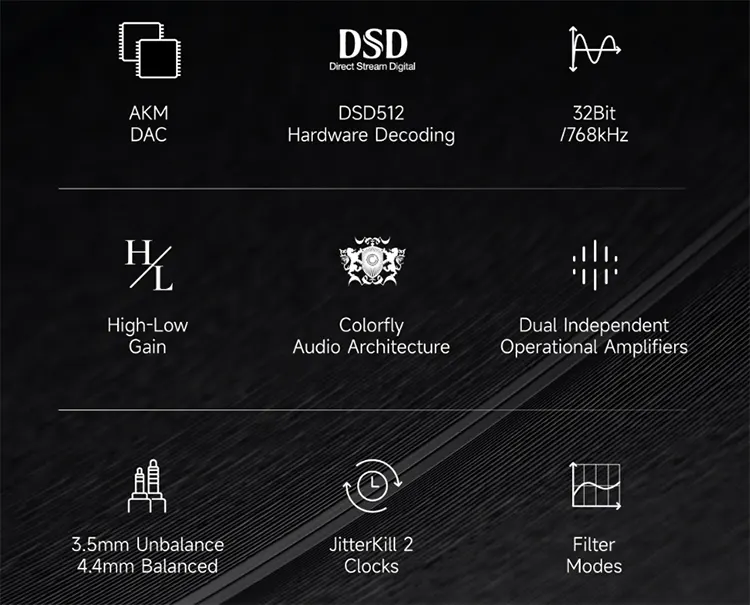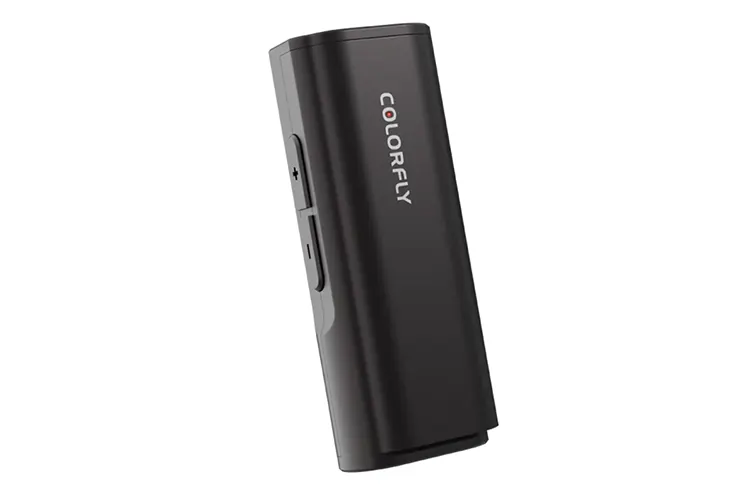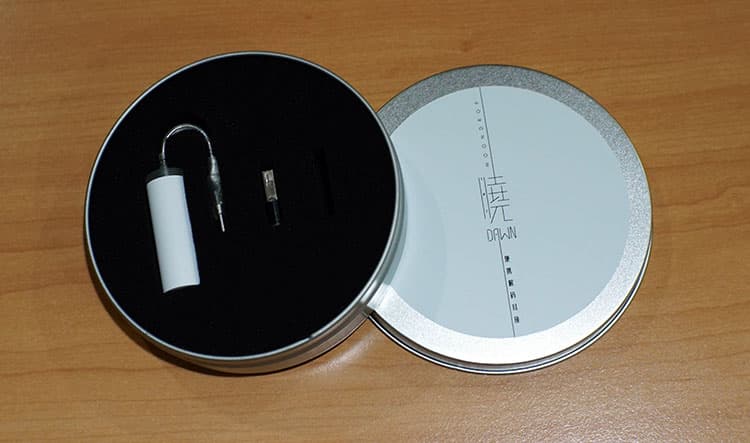In this review, Kurt tests the performance and features of the Colorfly CDA-M1P, which is an affordable dongle DAC for audiophiles and gamers offering up to DSD512 decoding and 240mW of balanced output power. It is priced at $79.00.
Disclaimer: This is a sample sent to us in exchange for our honest opinion. Headfonics is an independent website with no affiliate links or status. We thank Colorfly & Shenzhen Audio for this opportunity.
To read more about Colorfly products that we have previously covered on Headfonics click here.
Note, that this article follows our latest scoring guidelines which you can read up on here.
Colorfly is one of those indie brands that pop up now and then with some very interesting portable audio offerings. For those with a long memory, they were one of the first companies to launch an audiophile-level DAP, the C4 Pro, back in the noughties.
Fast forward to the here and now and they seem to be focusing heavily on the dongle DAC market with this, their new CDA-M1P which builds on the CDA M1 version reviewed by Louis on Headfonics a few years ago.
The latest version is priced competitively at $79.99 but then again, there are a lot of dongles at a similar price point so the competition is quite stuff.
The CDA-M1P does have several unique features that we tested in this review, particularly for gamers, as well as some impressive output power specs that should give it a broader appeal.

Tech Highlights
The Colorfly CDA-M1P uses an AKM AK4493SEQ 32-bit DAC with low distortion and wide dynamic range and is compatible with all types of devices, either Android, Windows, or iOS.
It’s capable of PCM 32bit/768kHz and native DSD512 decoding with a JitterKill 2 Femtosecond Clock system to hammer down on traditional digital audio jitter issues. You also get 6 digital filter options drawn directly from the AKM DAC chipset.
The Colorfly CDA-M1P offers both balanced and unbalanced output capability with a dedicated XR2001 opamp per output as well as a dual gain system, (high/low).
Going single-ended you get a maximum of 125mW into a 32Ω load whilst the balanced 4.4mm output delivers up to 240mW on the same load which is quite decent for a dongle at this price point.
Design
The Colorfly CDA-M1P comes in a zinc alloy electroplated body that has gone through CNC precision casting. Its form factor is well-built and sturdy.
I can feel how premium the Colorfly CDA-M1P is with its metal unibody construction. It one-ups competing dongles that use a plastic body or a plastic-metal body.
Although the Colorfly CDA-M1P’s design is clean and sleek, it does offer a downside with some higher-than-expected heat levels during use. After 30 minutes of usage, the Colorfly CDA-M1P gets very hot, making me unable to hold it at all. I could only use it as a desktop DAC amplifier due to this issue.
It also has an LED indicator inside the ‘O’ in the word Colorfly. The position of the LED indicator hole isn’t in the center of the ‘O’ though which is a slight annoyance. The light is dim in daylight though so it’ll be hard to see what color it’s currently in.
I/O
The Colorfly CDA-M1P features both 3.5mm and 4.4mm PO ports to the front with a USB Type-C connector for charging, USB-DAC, and USB-OTG duties.
There isn’t a version with a lightning port though, but changing the stock cable to a lightning to USB-C cable works fine for iOS devices.
Mind you with the latest version of the iPhone coming with USB-C this issue will soon be moot for new owners.
The LED indicator also shows 6 different colors depending on the USB Mode, gain, and sample rate being received by the dongle.
For USB 1.0 it’s pretty simple low gain and high gain with a fixed sample rate for both. For USB 2.0 you have 3 colors for PCM and DSD sample rates in low gain, and 3 colors for the same division of sample rates but in high gain.
Aside from that, it also has a volume memory capability which preserves the previous volume level you used despite changing audio devices.

Controls
The CDA-M1P’s volume buttons also act as multifunction controls for the gain level, digital filters, and gaming mode.
The digital filters can be accessed by long pressing the volume +/- button simultaneously with low or high gain options requiring the same +/- press but without the long hold.
You can switch to the UAC 1.0 mode for gaming on the likes of the PS5 and Switch by pressing and holding the volume + button only.
The UAC 1.0 mode only supports up to 16 bit/44.1kHz, which is normal CD quality but is more compatible with gaming consoles.
The Colorfly CDA-M1P seems to automatically go to UAC 1.0 mode when I use it for gaming. The audio cuts out for a second and then automatically switches to UAC 1.0 mode. From my experience, when it returns to UAC 2.0 mode there is a noticeable bump in the audio quality and clarity.
Wired Connectivity
USB-DAC
Using it on Windows 11, it’s simply plug-and-play. There is no need to download drivers elsewhere to make it work.
In Windows 11’s Sounds Settings, you can select it to play up to 32BIT/384kHz studio quality or 16BIT/44.1kHz at the minimum. Despite the quality change, it will still depend on your streaming platform and player if it supports that quality.
USB-OTG
Using it on my phone, there are no issues. It works as intended, but I do have concerns with its weight and temperature.
Having it dangle on your phone with its hefty weight is simply uncomfortable. Adding to that, its temperature gets endlessly hot since its body does a great job of conducting the heat.
I wouldn’t use this with a phone since using a dongle shouldn’t be this heavy or hot. Desktop usage on this is better.
Packaging & Accessories
Inside the box, there isn’t much to see. The accessories you get are just the essentials but the quality is good for the cable which is a high-purity single-crystal copper with silver-plated USB Type-C design.
It’s a pretty thing to look at with how clean and stylish its design is.
Aside from the cable you get a user manual with some in-depth information on the differing modes and filtering effects and that’s about it. There isn’t a carrying case or anything else.
Sound Impressions
Summary
I am impressed with how neutral-sounding the Colorfly CDA-M1P is. I don’t hear much coloration with it to any gear.
The bass sounds crisp and cleaner with my gear, which in this instance is the Thieaudio Hype 2. This IEM already has fantastic bass, but the Colorfly CDA-M1P just makes the bass more pronounced and cleaner.
On an IEM without much bass, like the Raptgo Bridge, its bass isn’t elevated. Rather, it’s less grainy and more refined.
I enjoy the bass of my gear a lot more while using the Colorfly CDA-M1P. It removes any foggy mess in the bass to achieve its true clean bass to show its full potential.
The mids are also cleaner. It doesn’t make it more forward or recessed, rather it just makes the clarity better.
Using it on bass cannon IEMs, like the Truthear Nova, it separates the vocals from the bass better than it normally is. Despite it making the separation better, it doesn’t make the vocals brighter or darker which stays true to it not adding coloration to the sound.
The treble is impressive. It made my entry-level gear have better detail retrieval, while also taming the sibilance a fair bit in all the gear I have.
I hear a tiny bit more detail while using the Colorfly CDA-M1P with any of my audio gear. I am impressed with how well it improves the sound without adding any coloration to the gear.
Timbre
The Colorfly CDA-M1P’s take on timbre is interesting. It affects both vocals and instrument timbre as well.
It’s a good change though since it removes the artificial sounding sharpening to them. It reveals the micro details in the vocals and instruments, like when the singer takes a breath in between verses for the vocals or how you can hear the guitarist’s fingers sliding through the fretboards.
Overall, the Colorfly CDA-M1P makes the timbre more natural with no drawbacks at all. It’s simply impressive.
Staging & Dynamics
This part of the Colorfly CDA-M1P impressed me the most. How it affects staging and dynamics is honestly excellent.
It adds a lot more width and also height to the soundstage. Using it with my Thieaudio Hype 2 which has an average soundstage, the Colorfly CDA-M1P makes the soundstage similar to the Moondrop Blessing 3.
Imaging is outstanding too. It makes it a lot more precise in its position than normal. Dynamics is done properly too. Normally, there is some part overpowering another part, but the Colorfly CDA-M1P properly normalizes them and makes everything shine.
Synergy
I’ve tried the Colorfly CDA-M1P with numerous IEMs. I’ve used it with the Thieaudio Hype 2, Truthear Nova, Raptgo Bridge, Moondrop Blessing 3, FiiO JD7, and the Truthear Hola, to name but a few.
The Colorfly CDA-M1P helped the most with the Raptgo Bridge though. The Raptgo Bridge originally sounded dull and lifeless but its soundstage was expansive. Using the Colorfly CDA-M1P made it sound alive, its timbre correct, and the hissing gone.
Hybrid IEMs and sensitive IEMs will benefit the most from the Colorfly CDA-M1P. Correcting the dynamics of these IEMs is a major step up as well.
Power was never an issue with it either. I can comfortably put the volume of my laptop at maximum and just control the Colorfly CDA-M1P’s built-in volume controls.
Select Comparisons
Shanling UA2
Technical
The Shanling UA2 uses the ESS ES9038Q2M chipset and supports up to native DSD512 and PCM 32BIT/768kHz decoding.
However, for amplification, it’s more old-school with a 2.5mm balanced output alongside a 3.5mm unbalanced output. The numbers are competitive though at 195mW for the balanced output, while 125mW for the unbalanced output on a 32Ω load.
Design
The Shanling UA2 has an all-black design metal unibody design. It doesn’t have a cable attached to it, so you don’t need to worry about any cables breaking and rendering it unusable.
There’s an LED indicator in the middle of the 2.5mm and 3.5mm outputs as well. On the top, there’s the Shanling logo, the Hi-Res logo, and some DSD512 printing.
Performance
Both the Colorfly CDA-M1P and Shanling UA2 have clear distinct bass. I can describe it as being neutral and not colored in any way. For the mids, the Colorfly CDA-M1P has clearer vocals while the Shanling UA2 has a heavier note weight but is less clear.
Their differences in the treble lie in how they handle sibilance. The Shanling UA2 doesn’t do anything with sibilance, while the Colorfly CDA-M1P tames down the sibilance.
However, the Shanling UA2 does micro details better. I can hear micro details and other nuances with the Shanling UA2 that the Colorfly CDA-M1P doesn’t do.
The big difference they have is in the soundstage and imaging. The Shanling UA2 doesn’t do much about the soundstage since it follows the IEM’s soundstage, but the Colorfly CDA-M1P increases the soundstage width and height.
It’s a noticeable difference that I hear and experience. It makes the CDA-M1P’s overall usage more immersive.
Moondrop Dawn
Technical
The Moondrop Dawn uses a dual CS43131 chipset to give it a lot of power. It supports PCM 32BITt/768kHz and native DSD256 decoding which is a step below the Colorfly’s native DSD512 capability.
The Dawn only offers a 4.4mm balanced output, so no single-ended but it runs the Colorfly balanced output very close at 230mW of output power into a 32Ω load.
Design
The Dawn has a white and clear design. Its shell is white and made out of plastic, then at the connector part, it’s now a clear see-through plastic.
There’s an LED indicator on top near its Moondrop branding. The non-detachable cable is flimsy and weak, which makes it a worry for long-term use.
If the cable ever breaks, it will render the item unusable. Aside from that, the build feels cheap but it is not that conductive or heavy, which prevents it from getting extremely hot with usage.
Performance
The Moondrop Dawn doesn’t do anything with the bass like giving it clarity or cleaning it up. The Colorfly CDA-M1P, on the other hand, clears up any uneven or overpowering bass.
The bass is more detailed and textured with the CDA-M1P. The Dawn doesn’t do it, unfortunately.
For the mids, the Dawn makes the vocals more forward while adding more clarity to it. The CDA-M1P doesn’t give any forwardness to the vocals but it follows through with the clarity. They both offer a natural-0sounding instrumental and vocal timbre.
The treble differences are quite noticeable though. Microdetails are done better with the Colorfly CDA-M1P, there is a lot more sparkle and wow factor with it.
The soundstage is okay on the Moondrop Dawn, nothing surprising. The Colorfly CDA-M1P does soundstage better and has a more immersive take on it.
Our Verdict
The Colorfly CDA-M1P is a neutral color-free performer and an altogether no-nonsense dongle DAC for pairing with either IEM or headphones.
It offers above-average power from both single-ended and balanced outputs with an impressive range of Bit and sample rate decoding capability from that AKM DAC. I also appreciate the ability to switch from UAC 1.0 which I think will appeal to gaming nerds like me.
However, due to the heat generated and hefty weight, the portable aspect of it doesn’t seem ideal. Using it as a transportable USB-DAC works better to avoid concerns regarding temperature and weight when being handled.
Otherwise, the Colorfly CDA-M1P does check a lot of boxes as a competitive dongle DAC at this price point.
Colorfly CDA-M1P Technical Specifications
- Dimensions: 56 x 22 x 14.5mm
- Weight: 46 grams
- Decoding Formats: PCM 32bit/768kHz, DSD512/Native, DSD256/Dop
- Headphone Jack: 3.5mm Unbalanced, 4.4mm Balanced
- Output Level: Unbalanced 2Vrms, Balanced 4Vrms
- Maximum Output Power: Unbalanced 125mW, Balanced 240mW










